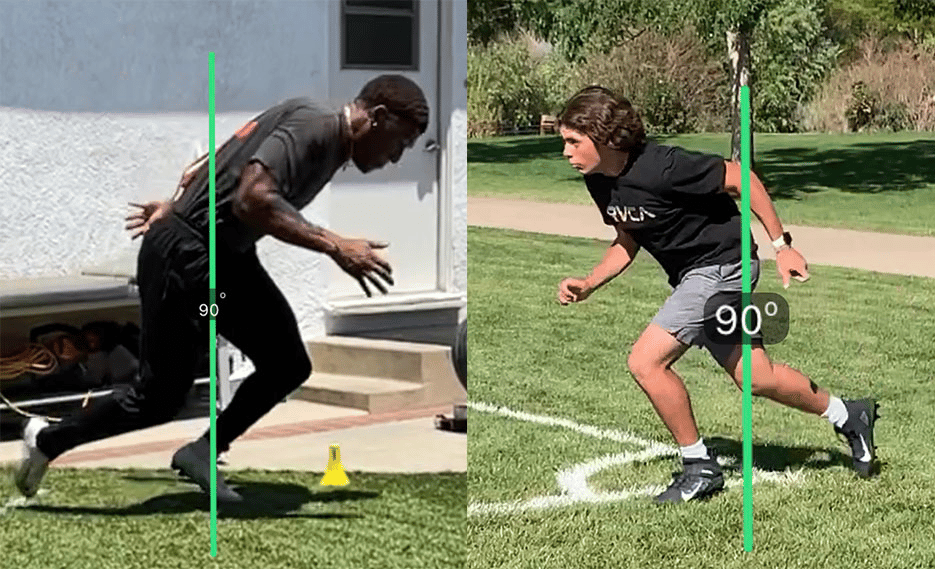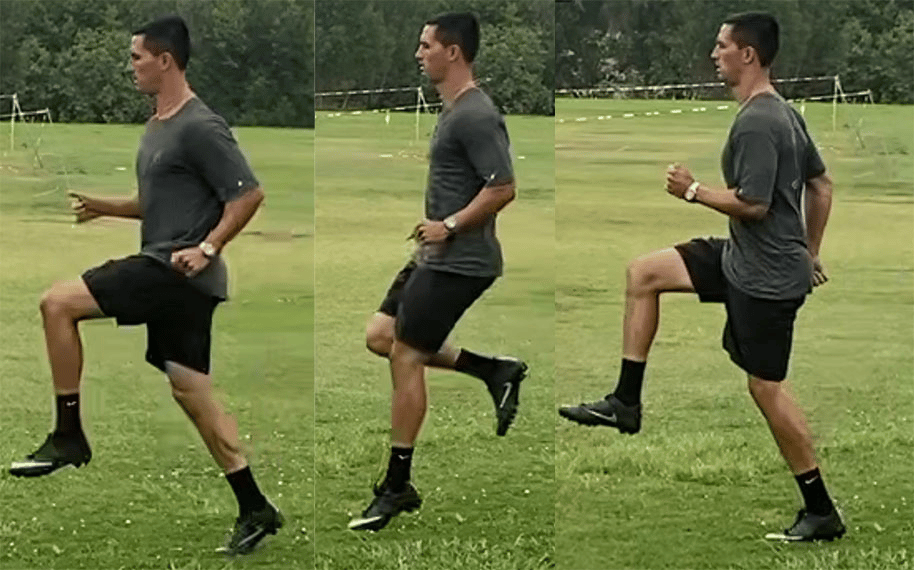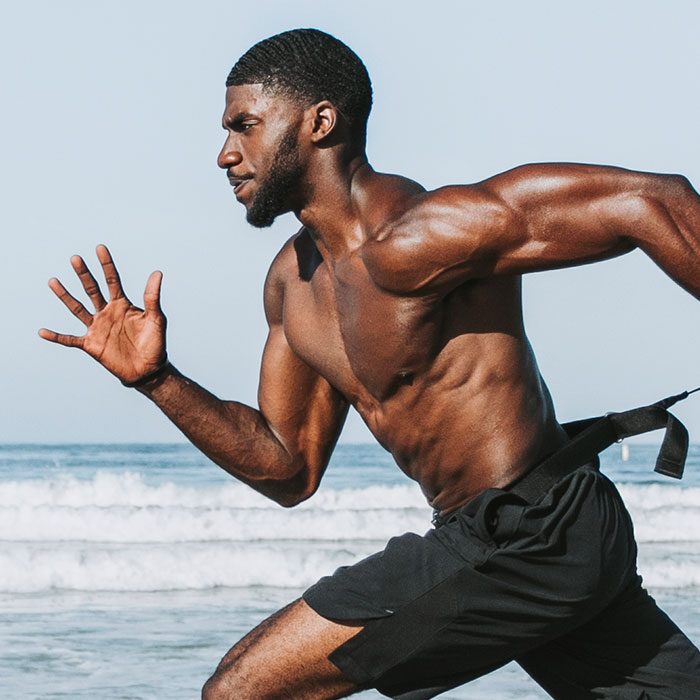3 Secrets To Getting Faster Immediately (How To Get Faster)
Hey, what’s up everyone Morey Croson here and today I want to be going over the three basic fundamentals of improving your running speed, and then how you could actually improve in those areas, we’re going to go into foot contact time, stride frequency and stride length. And I want to go a little bit into each of them, providing speed workouts.
1. Stride Length
We’ll start off with number one here, stride length. And the big thing that ends up going into stride length is how much force is being created into the ground at maximum speed. So when you are striking the ground, the most effective way to improve your speed is strike the ground with both vertical and horizontal force. The key differentiator between elite sprinters and novice sprinters is force into the ground, so in order to run faster speeds you must generate more ground force both vertically and horizontally.

Most athletes can get faster by increasing horizontal force into the ground. This means when the foot strikes the ground, the leg should be moving back towards the body, while simultaneously extending towards the ground. (See below). The mistake many athletes make in their running form is striking straight down which leads to more energy being put straight down into the ground, in compared to back and down. This is critical to increase speed and should be incorporate speed workouts and speed training.

Top 10 Secrets To Improve Speed Immediately
Another Big Part Of Stride Length Is Mobility.
If you end up being really stiff within your hips or within your spine and upper. that will also impact your ability to to really maximize your stride length and sprinting technique. This is why it is important to be very aware of your speed drills and really maximizing your sprint technique. Most runners are not locked in during their warm up and therefore struggle to get faster. Every time the foot strikes the ground, be sure to be active with the spine and upper body to develop the correct timing to generate more power and increase stride length.
Here is a great video on how your upper body can increase your speed:
2. Leg Turnover/Stride Frequency
The next important part to run faster is leg turnover which is essentially how much time is spent with your foot off the ground. There are a lot of things that impacts how fast the lower body cycles, from running shoes, fast twitch muscle fibers, coordination, running schedule and much more. We will get into a couple main concepts that will give you the biggest ROI to use in your training program.
In order to improve leg speed, you must learn to be an efficient runner which means no wasted time with your foot going back behind the body. I see many athletes who either have bad running shoes or poor foot range of motion which gives them this long leg cycle when at top speed. This is terrible for anyone looking to run faster because it impacts front side mechanics as well as ground contact. Instead, the best way is to maintain the foot more underneath the hip in order to get good high knees and knee bend after toe off.
Core Strength And Hip Flexor Strength is always going to be important to improve speed and start running faster because they impact both stride length and heart rate. Most sprinters incorporate hip flexor strengthening into their strength training program and I recommend that for you as well. Training the core muscles can be done during a speed workout as well as in the strength training program. Just be sure to implement exercises that improve the core muscles in all three planes and not just the sagittal plane which would be exercises such as sit ups or planks.
How Tempo Runs Impact Running Faster
Now there is a lot of benefit that comes from tempo runs or different types of interval training. In my opinion, interval training workouts are not nearly as beneficial as working on building speed or focused running technique days. With that said, everyone has a different running schedule that works better for them. When it comes to build fast twitch muscle fiber and increasing maximum speed, you want to work at a high intensity and run hard with good form. There does not need to be many long runs or easy jogging especially when it comes to improving leg speed.
3. Foot Contact Time
How you strike the ground is crucial in helping you push yourself off the ground. In order to be a competitive runner and sprint faster you have to understand foot contact and how to use both power and force with quickness and efficiency. A lot of that can be improve by just understanding body alignment and positioning during foot strike.
How You Start Is Critical To How You Finish
The first four steps are the most critical in your sprint. Right off the bat, you need to get your foot down as quickly as possible within your first step. You want to make sure your heel is not going too far inwards when your foot initially hits the ground; doing this will create an internal rotation, which makes it harder to maintain a neutral position. When your toes are outside the knee when landing the time on the ground is longer because of the absorption time. In comparison to when the toes are even with the knee or inside the knee when landing, the ankle and hip are now set up to absorb the force quickly and limit time on the ground.

Why How You Land Is So Important To Build Speed
A lot of your overall performance as an athlete or sprinter will come from your ability to properly strike the ground. When starting or accelerating it is really important to be able to cover both great distance while maintaining quick foot contact. When you see an explosive athlete with amazing acceleration, they are utilizing effective range in their leg cycle, combined with fast and efficient ground contact. We will give you some training techniques below to help improve your running time.

So How Does This Make You A Faster And Stronger Runner
When it comes to running speed there is a direct correlation between ground force or the amount of force that is put into the ground, with overall speed. So when looking at the picture above you can see the athlete goes from very internally rotated with the hip while at max hip flexion or when the knee is at it’s highest point. To an externally rotated position when the foot hits the ground with more of the weight forward.
What Generates The Most Force?
Since we know that ground force is critical to increase your running speed. The question is what must be done in order to RUN FASTER. If you just stomp into the ground that will generate more force into the ground but will not help you propel forward and actually run faster.

Land With The Foot Underneath The Hip
A key indicator to easily determine if the foot is striking the ground correctly is the position of the foot in comparison to the hip at contact. For both athletes above they are both taking their first step but we see two very different positions.
1. The athlete on the left is striking the ground with the foot directly underneath the hip.
2. Foot orientation, the athlete on the left is landing on the ball of the foot with the heel high and weight forward. In comparison to the athlete on the right where the athlete is landing in the middle of the foot, heel down and weight more back. (This will cause the foot to be on the ground much longer)
3. Shin angle, the shin angle makes a big difference in order to build speed. The athlete on the left has a downward facing shin in comparison to the athlete on the right where the shin is facing straight ahead.
4. Spine alignment, the position of the head, neck and spine make a huge impact when it comes to faster running. When the chin comes up and the spine rounds in comparison to keeping the chin tucked and the spine in a strong neutral position will make a tremendous difference in top end speed.
The Ability To Pull The Foot Underneath The Hip

Now that we have gotten into how to get into the correct hip position, we will go into the actual action of generating force into the ground. This comes from the ability to pull the foot back underneath the hip. We see Noah Lyles above who is the current 200m Olympic and World Champion showing excellent form.
In order to increase your speed you must learn how to contact the ground. When speed training on the track or doing weight training, there should always be a reminder of ‘how is my foot contacting the ground’. This is really important to consider when doing heavy weight training exercises as well as plyometric exercises. How is the foot landing? Where is the heel? Is the foot underneath the hip? Be aware when you are working out!
Drills to Improve Front Side Mechanics
Here are a few drills to add to your speed workout and help with your front side mechanics, foot contact as well as foot strike. These can be done before speed workouts and should be done at least 2-3 times a week in order to get the best results.
Straight Leg Run

Make sure to have arm action when doing this running form drill. Key thing here is toes up and keep the legs straight and you want to focus on pulling the leg back so it is landing right underneath the hip.
High Knee Run

This is a good drill to help with getting the foot contact down where you can work getting the foot off the ground quickly when landing. Additionally, quickly driving the knees up and through to transition into the next step. When building speed it is important to understand that the ability to control your movement is critical to improve your speed.
Bounds

For more speed workouts you can check out this blog:
Best Leg Workouts To Get Faster
Conclusion
The reality is in order to get faster, you need stronger muscles and better sprint technique. There are a wide variety of ways to increase overall strength such as hill sprints, strength training, eating a balanced diet and much more. While many runners rely on tempo run and fatlek runs to improve technique I would argue that does not help become a faster runner.
In order to improve top speed running for then the practice must be above 90% intensity. While that may require more rest days it is a much better speed play then running longer distances or wasting time on a tempo run. The best speed work comes from a running program that implements both speed and consistent training of plyometrics and strength.
So those are some of the keys for how to improve your running speed if you liked the information presented in this post, feel free to check out our official website for more such information. We offer various programs to help you become a better athlete. Get sprints exercises and discover more content for athletes and teams by visiting our YouTube channel.









